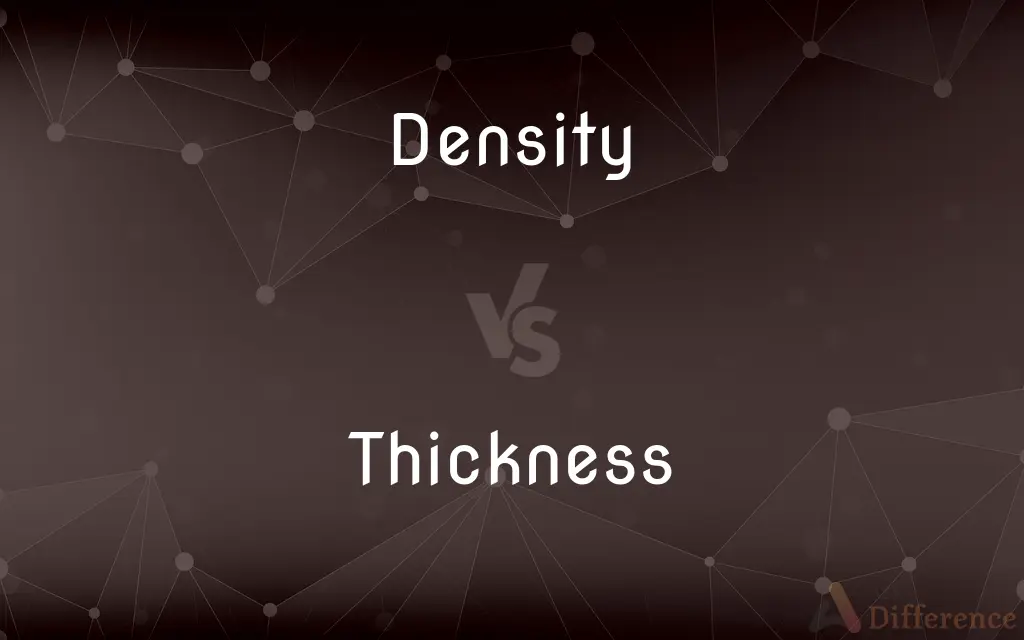Density vs. Thickness — What's the Difference?
By Fiza Rafique & Maham Liaqat — Updated on April 26, 2024
Density describes mass per unit volume, crucial in material properties, while thickness measures an object's dimension from one surface to another.

Difference Between Density and Thickness
Table of Contents
ADVERTISEMENT
Key Differences
Density refers to how closely packed the particles in a material are, indicating mass per unit volume. In contrast, thickness measures the extent from one surface to an opposite surface of an object, often measured in millimeters or inches.
While density is a fundamental property used to classify substances and affects attributes like buoyancy and stability, thickness primarily impacts the structural and functional aspects of materials, such as insulation and strength.
Materials can have the same thickness but different densities, affecting their overall weight and performance. Conversely, materials with similar densities can vary significantly in thickness, influencing their application and effectiveness in different roles.
The measurement of density is crucial in fields like metallurgy and chemistry, where it helps in identifying substances and predicting their behavior. On the other hand, thickness is often more relevant in engineering and construction, where it relates to dimensions and tolerances.
Understanding the density of a material helps in calculating its weight and required quantities for specific volumes, whereas knowing the thickness is essential for fitting and manufacturing processes.
ADVERTISEMENT
Comparison Chart
Definition
Mass per unit volume
Distance between two surfaces
Units
Typically grams per cubic centimeter (g/cm³)
Millimeters (mm) or inches (in)
Relevance
Identifying substances, predicting behavior
Dimensional specifications, construction
Affected Properties
Weight, buoyancy, stability
Insulation, strength, fitting
Measurement Tools
Hydrometer, pycnometer
Ruler, caliper
Compare with Definitions
Density
A measurement indicating how compact a substance is.
Lead has a high density, making it very heavy for its size.
Thickness
Important dimension in manufacturing and construction.
Correct thickness is crucial for the door to fit the frame.
Density
Influences the sinking or floating of objects in fluids.
An object denser than water will sink.
Thickness
Measurement from one surface of a material to the opposite surface.
The thickness of that glass pane is 2 mm.
Density
Mass per unit volume in a material.
The density of water is 1 g/cm³.
Thickness
Integral to structural integrity and performance.
The thickness of steel plates used in construction determines their strength.
Density
Key in calculating mass and volume.
To find the mass, multiply the density by the volume.
Thickness
Often measured using tools like rulers and calipers.
Use a caliper to measure the thickness accurately.
Density
Used to compare the compactness of different materials.
Metals generally have higher densities than plastics.
Thickness
Can affect the transparency and insulation of materials.
Thicker curtains block more light and provide better insulation.
Density
The density (more precisely, the volumetric mass density; also known as specific mass), of a substance is its mass per unit volume. The symbol most often used for density is ρ (the lower case Greek letter rho), although the Latin letter D can also be used.
Thickness
The quality or condition of being thick.
Density
The quality or condition of being dense.
Thickness
The dimension between two surfaces of an object, usually the dimension of smallest measure.
Density
The quantity of something per unit measure, especially per unit length, area, or volume.
Thickness
A layer, sheet, stratum, or ply
Each floor is a single thickness of concrete.
Density
The mass per unit volume of a substance under specified conditions of pressure and temperature.
Thickness
(uncountable) The property of being thick (in dimension).
Density
(Computers) A measure of the number of bits that can be stored in a given amount of physical space on a storage medium.
Thickness
A measure of how thick (in dimension) something is.
The thickness of the Earth's crust varies from two to 70 kilometres.
Guitar picks come in different thicknesses.
Density
The number of individuals, such as inhabitants or housing units, per unit of area.
Thickness
(countable) A layer.
We upholstered the seat with three thicknesses of cloth to make it more comfortable to sit on.
Density
The degree of optical opacity of a medium or material, as of a photographic negative.
Thickness
(uncountable) The quality of being thick (in consistency).
Whip the cream until it reaches a good thickness.
Density
Thickness of consistency; impenetrability.
Thickness
The property of being thick (slow to understand).
Density
Complexity of structure or content.
Thickness
(transitive) To trim (wood) to a consistent thickness using a thickness planer.
Density
Stupidity; dullness.
Thickness
The quality or state of being thick (in any of the senses of the adjective).
Density
(physics) A measure of the mass of matter contained by a unit volume.
Thickness
The dimension through an object as opposed to its length or width
Density
The ratio of one quantity, representing something of interest, to another quantity representing space, area, or extent in which the thing of interest is distributed.
The number of particles per unit volume of a specified volume can be considered to be the particle density for the specified volume.
Thickness
Used of a line or mark
Density
The probability that an outcome will fall into a given range, per unit of that range; the relative likelihood of possible values of a continuous random variable.
Thickness
Resistance to flow
Density
Stupidity; denseness.
Density
The quality of being dense, close, or thick; compactness; - opposed to rarity.
Density
The ratio of mass, or quantity of matter, to bulk or volume, esp. as compared with the mass and volume of a portion of some substance used as a standard.
Density
Depth of shade.
Density
The amount per unit size
Density
The spatial property of being crowded together
Common Curiosities
What is density?
Density is the mass of a substance per unit volume.
How is thickness measured?
Thickness is typically measured using tools like rulers or calipers.
Can two materials of the same thickness have different densities?
Yes, materials with the same thickness can have different densities.
Why is density important?
Density helps in identifying substances, determining their stability, and predicting their behavior in different conditions.
Does thickness affect insulation?
Yes, generally, thicker materials provide better insulation than thinner ones.
How does the density of water compare to that of air?
Water is much denser than air, which is why air bubbles rise to the surface in water.
What role does thickness play in construction?
Thickness is crucial for ensuring that materials meet structural and functional requirements in construction projects.
How does density affect buoyancy?
An object will float if its density is less than the fluid it is in and sink if it is more.
What units are used to measure density?
Density is usually measured in grams per cubic centimeter (g/cm³) or kilograms per cubic meter (kg/m³).
What units are used to measure thickness?
Thickness is typically measured in millimeters (mm) or inches (in).
Is thickness the same as width?
No, thickness specifically refers to the dimension between two opposite surfaces, while width can refer to a measurement across an object's surface.
Share Your Discovery

Previous Comparison
Group vs. Community
Next Comparison
Hound vs. DogAuthor Spotlight
Written by
Fiza RafiqueFiza Rafique is a skilled content writer at AskDifference.com, where she meticulously refines and enhances written pieces. Drawing from her vast editorial expertise, Fiza ensures clarity, accuracy, and precision in every article. Passionate about language, she continually seeks to elevate the quality of content for readers worldwide.
Co-written by
Maham Liaqat













































